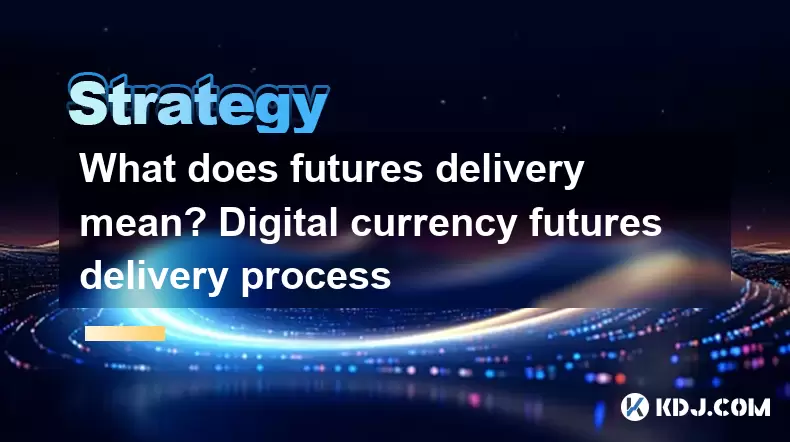-
 bitcoin
bitcoin $114320.977035 USD
-0.40% -
 ethereum
ethereum $4152.439985 USD
-1.75% -
 tether
tether $1.000111 USD
-0.04% -
 xrp
xrp $2.843037 USD
-1.63% -
 bnb
bnb $1013.349380 USD
-1.62% -
 solana
solana $208.362767 USD
-2.10% -
 usd-coin
usd-coin $0.999783 USD
0.00% -
 dogecoin
dogecoin $0.232559 USD
-1.00% -
 tron
tron $0.333491 USD
-1.09% -
 cardano
cardano $0.806310 USD
0.19% -
 hyperliquid
hyperliquid $45.023720 USD
-1.59% -
 ethena-usde
ethena-usde $1.000819 USD
-0.06% -
 chainlink
chainlink $21.241249 USD
-2.11% -
 avalanche
avalanche $30.035416 USD
-0.66% -
 stellar
stellar $0.364984 USD
-2.05%
What does futures delivery mean? Digital currency futures delivery process
Futures delivery in digital currencies involves transferring the actual cryptocurrency to the buyer upon contract expiration, ensuring market integrity and enabling price-locked acquisition.
Jun 02, 2025 at 02:56 am

In the world of digital currencies, futures trading has become a popular method for investors to speculate on the price movements of cryptocurrencies like Bitcoin and Ethereum. One key aspect of futures trading is the concept of futures delivery. This article will delve into what futures delivery means in the context of digital currencies and outline the detailed process involved in executing a futures delivery.
Understanding Futures Delivery in Digital Currencies
Futures delivery, in the context of digital currencies, refers to the process by which the underlying asset, in this case, a cryptocurrency, is transferred from the seller to the buyer upon the expiration of a futures contract. Unlike traditional futures contracts where physical delivery of goods like oil or wheat might occur, digital currency futures typically involve the transfer of the actual cryptocurrency tokens.
Futures delivery can be executed in two main ways: physical delivery and cash settlement. In the realm of digital currencies, physical delivery is more common, where the actual cryptocurrency is transferred to the buyer's wallet. Cash settlement, on the other hand, involves settling the contract in cash based on the price of the cryptocurrency at the time of expiration.
The Importance of Futures Delivery
The concept of futures delivery is crucial for several reasons. Firstly, it ensures that the futures market remains a reliable and transparent platform for trading. By enforcing delivery, exchanges ensure that all parties fulfill their contractual obligations, thereby maintaining market integrity. Secondly, it provides an opportunity for investors to acquire the underlying cryptocurrency at a predetermined price, which can be beneficial in volatile markets.
The Process of Futures Delivery in Digital Currencies
The process of executing a futures delivery in digital currencies involves several steps. Let's break down the process in detail:
Contract Expiration: The first step in the delivery process is the expiration of the futures contract. This is the date on which the contract must be settled. Exchanges will notify traders of the upcoming expiration and any necessary actions they need to take.
Settlement Price Determination: Once the contract expires, the settlement price of the cryptocurrency is determined. This price is usually based on the average price of the cryptocurrency over a specific period around the expiration time. The settlement price is crucial as it determines the amount of cryptocurrency that will be delivered.
Delivery Notification: After the settlement price is determined, the exchange will notify both the buyer and the seller of the delivery details. This includes the amount of cryptocurrency to be delivered and the wallet address to which the cryptocurrency should be transferred.
Transfer of Cryptocurrency: The seller then initiates the transfer of the cryptocurrency to the buyer's wallet. This transfer is usually done directly through the blockchain network of the cryptocurrency in question. The exchange may provide a platform or interface to facilitate this transfer.
Confirmation of Delivery: Once the transfer is complete, the buyer must confirm receipt of the cryptocurrency. This confirmation is typically done through the exchange's platform, ensuring that the delivery process is completed successfully.
Finalization of the Contract: After the delivery is confirmed, the futures contract is considered finalized. Both parties have fulfilled their obligations, and the transaction is recorded on the exchange's ledger.
Challenges and Considerations in Futures Delivery
While the process of futures delivery in digital currencies is straightforward, there are several challenges and considerations that traders should be aware of. One major challenge is the volatility of cryptocurrency prices. The price of the cryptocurrency can fluctuate significantly between the time the contract is entered into and its expiration, affecting the profitability of the trade.
Another consideration is the security of the transfer. Since the delivery involves transferring actual cryptocurrency tokens, there is a risk of hacks or errors during the transfer process. Traders must ensure that they use secure wallets and follow best practices for cryptocurrency transactions.
Additionally, regulatory considerations can impact the delivery process. Different jurisdictions may have varying rules regarding the trading and delivery of digital currency futures, and traders must comply with these regulations to avoid legal issues.
Ensuring a Smooth Futures Delivery
To ensure a smooth futures delivery process, traders should take several steps:
Monitor Contract Expiration: Keep track of the expiration dates of your futures contracts and be prepared to take action when they approach.
Understand Settlement Procedures: Familiarize yourself with the settlement procedures of the exchange you are using. Different exchanges may have slightly different processes for determining the settlement price and executing the delivery.
Secure Your Wallets: Use secure, reputable wallets for receiving the delivered cryptocurrency. Ensure that your wallet addresses are correctly provided to the exchange and the seller.
Stay Informed on Regulations: Keep up to date with the regulatory environment surrounding digital currency futures in your jurisdiction. Compliance with regulations is crucial for a smooth delivery process.
Verify Transactions: After receiving the cryptocurrency, verify the transaction on the blockchain to ensure that the delivery was successful and the correct amount was transferred.
Frequently Asked Questions
Q: Can I choose between physical delivery and cash settlement for digital currency futures?A: It depends on the exchange and the specific futures contract. Some exchanges offer both options, while others may only support physical delivery for digital currency futures. Always check the contract specifications before trading.
Q: What happens if I am unable to deliver the cryptocurrency when the futures contract expires?A: If you are unable to deliver the cryptocurrency, you may face penalties or fines from the exchange. In some cases, the exchange may automatically close your position at the market price, which could result in losses if the market has moved against you.
Q: Are there any fees associated with the futures delivery process?A: Yes, there may be fees associated with the futures delivery process. These can include transaction fees for transferring the cryptocurrency, as well as any fees charged by the exchange for facilitating the delivery. Always check the fee structure of the exchange before trading.
Q: Can I trade digital currency futures without intending to take delivery?A: Yes, many traders engage in futures trading without intending to take delivery. They typically close their positions before the contract expires, thereby avoiding the delivery process. This strategy is known as 'rolling over' the contract.
Disclaimer:info@kdj.com
The information provided is not trading advice. kdj.com does not assume any responsibility for any investments made based on the information provided in this article. Cryptocurrencies are highly volatile and it is highly recommended that you invest with caution after thorough research!
If you believe that the content used on this website infringes your copyright, please contact us immediately (info@kdj.com) and we will delete it promptly.
- BlockDAG, DOGE, HYPE Sponsorship: Crypto Trends Shaping 2025
- 2025-10-01 00:25:13
- Deutsche Börse and Circle: A StableCoin Adoption Powerhouse in Europe
- 2025-10-01 00:25:13
- BlockDAG's Presale Buzz: Is It the Crypto to Watch in October 2025?
- 2025-10-01 00:30:13
- Bitcoin, Crypto, and IQ: When Genius Meets Digital Gold?
- 2025-10-01 00:30:13
- Stablecoins, American Innovation, and Wallet Tokens: The Next Frontier
- 2025-10-01 00:35:12
- NBU, Coins, and Crypto in Ukraine: A New Yorker's Take
- 2025-10-01 00:45:14
Related knowledge

Practical parameter settings for a Bitcoin multi-timeframe moving average system
Sep 18,2025 at 10:54pm
Optimizing Timeframe Combinations for Bitcoin Trading1. Selecting appropriate timeframes is crucial when building a multi-timeframe moving average sys...

How can I filter out false breakouts in Dogecoin high-frequency trading?
Sep 22,2025 at 01:00am
Understanding False Breakouts in Dogecoin Trading1. A false breakout occurs when Dogecoin's price appears to move beyond a defined support or resistan...

Techniques for identifying tops and bottoms in the Bitcoin on-chain NVT model
Sep 20,2025 at 07:54pm
Understanding the NVT Model in Bitcoin Analysis1. The Network Value to Transactions (NVT) ratio is often described as the 'P/E ratio' of the cryptocur...

What does the surge in open interest in Bitcoincoin futures mean?
Sep 20,2025 at 11:18pm
Understanding the Surge in Dogecoin Futures Open Interest1. A surge in open interest within Dogecoin futures indicates a growing number of active cont...

How can I use the Ethereum USDT premium to gauge market sentiment?
Sep 18,2025 at 11:55pm
Understanding the Ethereum USDT Premium1. The Ethereum USDT premium refers to the price difference between USDT (Tether) traded on Ethereum-based plat...

What should I do if Ethereum staking yields decline?
Sep 20,2025 at 06:18am
Understanding the Causes Behind Declining Ethereum Staking Yields1. The Ethereum network transitioned to a proof-of-stake consensus mechanism with the...

Practical parameter settings for a Bitcoin multi-timeframe moving average system
Sep 18,2025 at 10:54pm
Optimizing Timeframe Combinations for Bitcoin Trading1. Selecting appropriate timeframes is crucial when building a multi-timeframe moving average sys...

How can I filter out false breakouts in Dogecoin high-frequency trading?
Sep 22,2025 at 01:00am
Understanding False Breakouts in Dogecoin Trading1. A false breakout occurs when Dogecoin's price appears to move beyond a defined support or resistan...

Techniques for identifying tops and bottoms in the Bitcoin on-chain NVT model
Sep 20,2025 at 07:54pm
Understanding the NVT Model in Bitcoin Analysis1. The Network Value to Transactions (NVT) ratio is often described as the 'P/E ratio' of the cryptocur...

What does the surge in open interest in Bitcoincoin futures mean?
Sep 20,2025 at 11:18pm
Understanding the Surge in Dogecoin Futures Open Interest1. A surge in open interest within Dogecoin futures indicates a growing number of active cont...

How can I use the Ethereum USDT premium to gauge market sentiment?
Sep 18,2025 at 11:55pm
Understanding the Ethereum USDT Premium1. The Ethereum USDT premium refers to the price difference between USDT (Tether) traded on Ethereum-based plat...

What should I do if Ethereum staking yields decline?
Sep 20,2025 at 06:18am
Understanding the Causes Behind Declining Ethereum Staking Yields1. The Ethereum network transitioned to a proof-of-stake consensus mechanism with the...
See all articles










































































